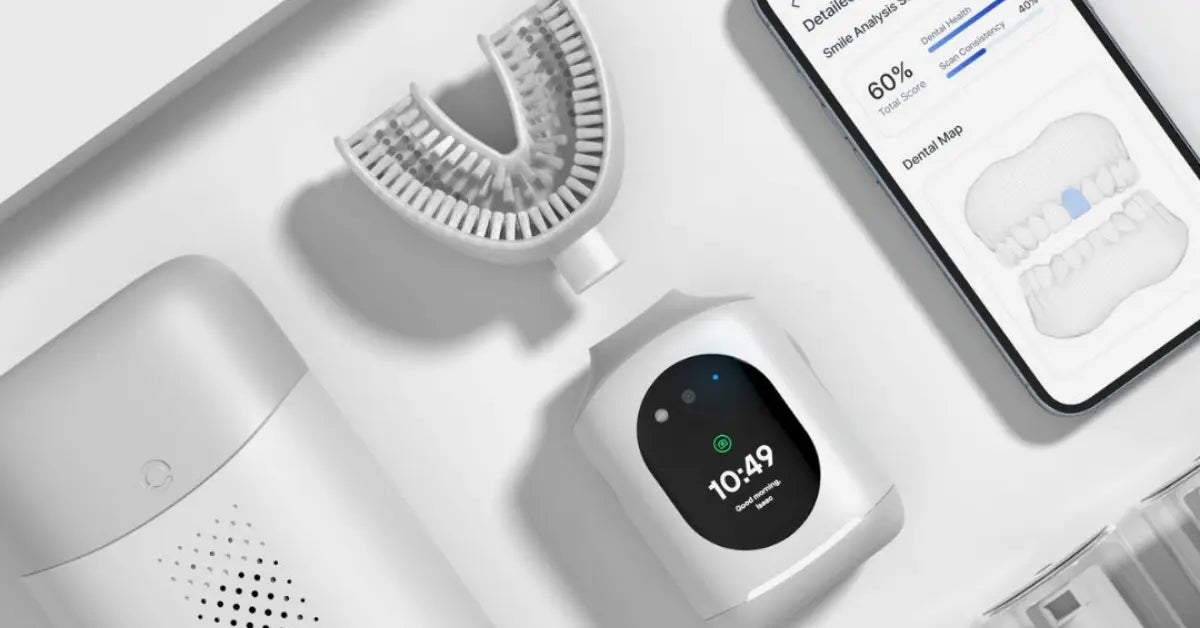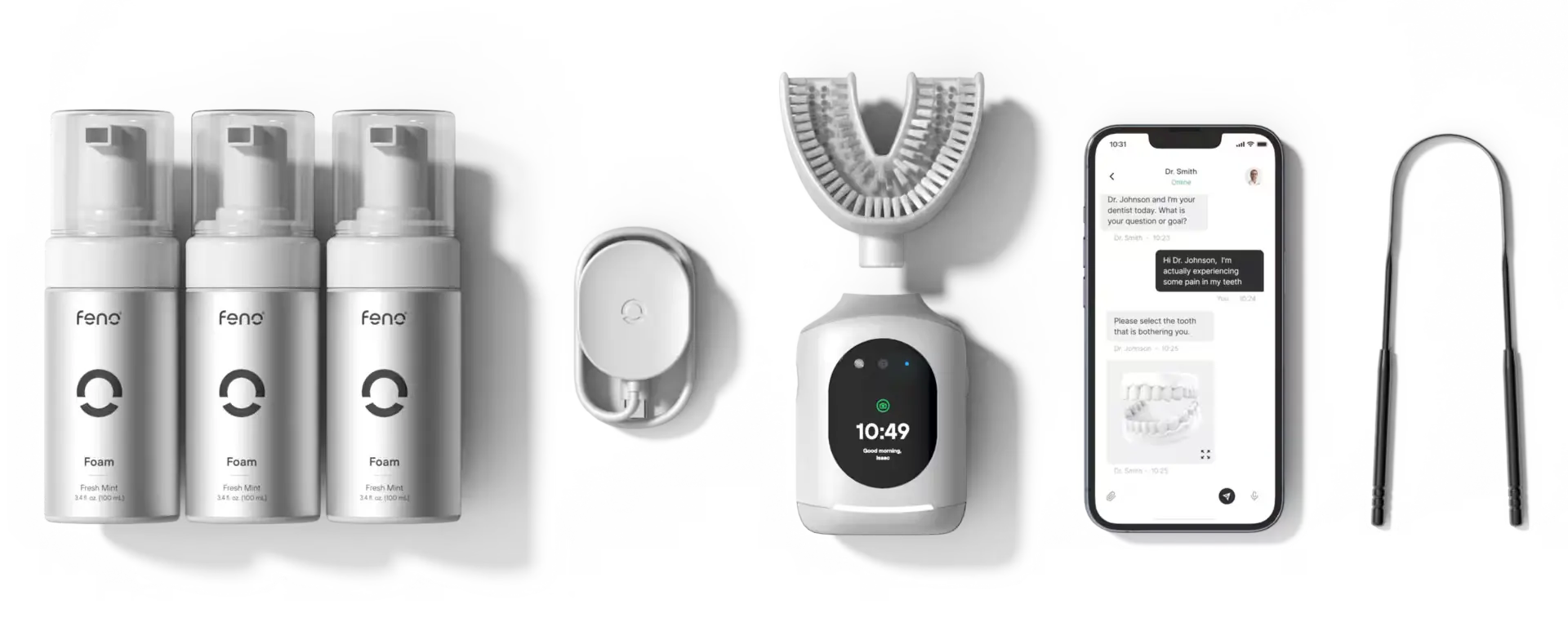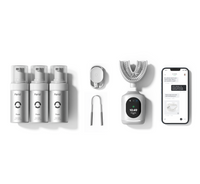
11 min read
Smart Toothbrushes vs. Traditional Brushes: Which Is Better for You?
Oral health is a critical component of overall well-being, affecting everything from digestion to self-esteem. Proper oral care prevents the accumulation of plaque, reduces the risk of gum disease, and maintains strong teeth. However, with advancements in technology, the tools available for maintaining oral health have evolved. This evolution brings us to a crossroads between traditional toothbrushes and smart oral care devices, each offering unique benefits. As we dive into this comparison, it's important to understand how essential regular and effective brushing is, not just for oral cleanliness but for preventing broader health issues.
Understanding Traditional Toothbrushes
Types of Traditional Toothbrushes
It comes in various forms, each designed to cater to different dental needs. The most common types are soft, medium, and hard bristles. Soft bristles are gentle on the gums and suitable for those with sensitive teeth or gingival issues. Medium bristles strike a balance between cleaning efficacy and softness, making them a popular choice for everyday use. Hard bristles, although less recommended by dentists due to their harshness on the gums and enamel, are preferred by some for their feeling of thorough cleaning.
The Benefits
Using traditional toothbrushes has several benefits that continue to make them a viable option for many. Primarily, they are straightforward to use without needing batteries or charging, making them perfect for travel or quick access. They are also significantly cheaper than their electronic counterparts, offering a cost-effective way to maintain dental hygiene. Moreover, manual toothbrushes are available in a wide range of styles and sizes, making it easy to find a fit that suits personal comfort and oral cavity size.
Proper Techniques for Optimal Oral Health
Maintaining optimal oral health with a traditional toothbrush is more than just routine brushing; it involves specific techniques that maximize effectiveness. By following the right steps, you can improve your dental hygiene significantly. Here’s a closer look at the essential practices to keep your teeth and gums healthy:
- Brush Twice Daily With Fluoride Toothpaste: Brushing twice daily with fluoride toothpaste is one of the most basic yet crucial steps in oral hygiene. Fluoride strengthens tooth enamel, making it more resistant to decay, while brushing in the morning and before bed helps remove plaque buildup. Morning brushing removes the bacteria accumulated overnight, while evening brushing clears food particles and plaque that developed during the day. Consistently brushing twice a day also helps prevent bad breath and reduces the risk of gum disease. Be mindful to use a pea-sized amount of toothpaste for adults, and consult your dentist if you have specific dental needs.
- Use Gentle Circular Motions: The technique you use while brushing plays a key role in achieving a thorough clean. Gentle circular motions are more effective than back-and-forth scrubbing because they allow the bristles to sweep away plaque without causing harm to your enamel or gums. Circular brushing helps ensure all surfaces of your teeth are cleaned evenly, especially along the gum line where plaque often accumulates. This method is also gentler on gums, minimizing the risk of irritation or gum recession, which can occur from aggressive brushing. Remember to angle your brush at 45 degrees to your gums for the best reach.
- Brush for at Least Two Minutes: The duration of each brushing session is as important as the technique. Brushing for at least two minutes allows enough time to clean every area of the mouth thoroughly, including the hard-to-reach spots like the back molars and spaces between teeth. Many people tend to brush for less time, missing key areas and leaving plaque behind. Setting a timer or using an electric toothbrush with a built-in timer can help ensure you reach the full two minutes. Focus on each quadrant of your mouth—upper left, upper right, lower left, and lower right—to ensure even cleaning across all surfaces.
- Replace Your Toothbrush Regularly: It’s recommended to replace your toothbrush every three to four months or sooner if the bristles become frayed. A worn toothbrush can’t reach all the nooks and crannies in your mouth and may harbor bacteria, potentially introducing more germs rather than cleaning them away. For best results, choose a toothbrush with soft bristles and inspect it regularly to determine when a replacement is needed. Regularly changing your toothbrush helps maintain its cleaning effectiveness and promotes better oral health.
Following these steps can lead to noticeable improvements in your dental hygiene, contributing to a healthier smile. Consistent care with these simple techniques can help protect your teeth and gums, ensuring long-term oral health.

Exploring Smart Toothbrushes and Their Benefits
The Features
Smart toothbrushes incorporate advanced dental care technology to enhance everyday oral hygiene. These devices often feature sensors that monitor pressure, angle, and coverage to ensure a thorough cleaning. Many are equipped with timers to guide users through the recommended two-minute brushing time, segmenting it by mouth quadrant to guarantee even cleaning. The inclusion of varying modes, such as deep cleaning, whitening, or sensitive gums, caters to a wide range of dental needs, making smart oral care devices a versatile choice for modern dental hygiene. The smart toothbrush cleaning efficiency lies in their ability to adjust to the user's brushing style and provide personalized feedback. These intelligent devices often have sensors that detect how well different areas of the mouth are being cleaned, prompting users to adjust their technique in real time. Dynamic adjustment helps prevent the overbrushing of certain areas, which can lead to enamel wear and gum recession while ensuring that no plaque build-up is missed.
The Types
The whole-mouth electric toothbrush, for instance, is particularly innovative as it departs from conventional brushing methods by cleaning all teeth simultaneously. This design saves time, reducing the brushing process to mere seconds, which can be a huge advantage for people with busy lifestyles or for those who find it challenging to brush effectively for two full minutes. The u-shaped toothbrush for adults, another innovative smart model, offers an entirely different approach by mimicking a mouthguard that encases all teeth. The design is particularly appealing for people who struggle with traditional brushing techniques or have limited dexterity, as it removes the need for precise hand movements. The U toothbrush uses ultrasonic or sonic vibrations to thoroughly clean the surfaces of teeth, including hard-to-reach areas that are often missed by traditional brushes. These designs exemplify how toothbrush technology advancements are reshaping our approach to oral care.
Real-Time Feedback and App Connectivity
The integration of real-time feedback and app connectivity in smart toothbrushes marks a significant advancement in oral health technology. These features transform the mundane task of brushing teeth into a data-driven activity that promotes better dental health. Here’s how they work together to elevate the brushing experience:
- Performance Tracking: The toothbrush collects data on how effectively each quadrant of the mouth is cleaned, from duration to brushing intensity. This data is sent to the companion app, which visualizes the information for users to review. By identifying under-brushed areas or overly aggressive brushing, users can make adjustments that lead to more balanced, effective cleaning. performance tracking helps users build better habits over time, ensuring that each part of the mouth receives adequate attention for optimal dental health.
- Customized Brushing Modes: Smart toothbrushes often come with different brushing modes tailored to various oral health needs, such as gum care, plaque removal, or teeth whitening. Through the app, users can receive recommendations on the best brushing mode for their specific goals. Customization helps users maximize the effectiveness of each brushing session, targeting their unique dental concerns. Someone aiming to reduce gum sensitivity may be guided toward a gentle mode, while others focusing on whitening may use a more intense setting. Personalized brushing modes contribute to more efficient care and enhance overall oral health by focusing on individual needs.
- Reminders for Brushing and Replacement: These reminders help users maintain consistent brushing habits, especially in busy schedules where it’s easy to forget. Notifications for brush head replacements also ensure that users aren’t using worn-out bristles, which can be less effective and may harbor bacteria. Staying on top of these reminders supports good oral hygiene by encouraging regular brushing and timely maintenance, enhancing both the efficacy and cleanliness of the brushing experience.
- Educational Content: Many apps provide access to valuable educational content on oral health, offering tips, tutorials, and insights on correct brushing techniques. This feature is especially beneficial for children learning proper habits or adults with specific dental needs. By accessing expert guidance and visual demonstrations, users can improve their brushing technique and understanding of dental care. This knowledge empowers users to adopt healthier practices, making informed choices that contribute to long-term oral health improvements. Educational content fosters awareness and can even inspire better daily habits among users of all ages.
- Gamification: Gamification brings an element of fun to brushing, making it especially engaging for younger users. By incorporating achievements, rewards, and interactive elements into the brushing experience, children and adults alike are motivated to brush consistently and correctly. For kids, games and progress trackers within the app turn brushing into a goal-oriented activity, reducing resistance and making dental care enjoyable. Gamification not only promotes consistency but also helps reinforce proper brushing techniques, turning routine tasks into an engaging and rewarding experience.
Integrating these features into a daily routine can lead to more mindful and effective brushing habits. Smart toothbrush technology supports users in taking control of their oral health, making dental care easier, more effective, and even enjoyable. By leveraging real-time feedback, personalized settings, and engaging features, these tools empower users to achieve better oral health outcomes with each use.

Innovations in Toothbrushes
Data Analysis
The best smart toothbrushes are increasingly capable of gathering and analyzing data on individual brushing patterns. Such capability extends beyond simple timing to detailed observations on pressure applied, stroke frequency, and coverage completeness. By analyzing this data, the accompanying apps can provide tailored advice to improve brushing habits, potentially highlighting neglected areas or recommending adjustments to prevent gum damage due to excessive pressure.
Wireless Connectivity
Wireless smart toothbrush technology integrates seamlessly with various smart devices, enhancing user interaction and accessibility. Through Bluetooth or Wi-Fi, these toothbrushes connect to smartphones and other smart home devices, allowing for an integrated health management experience. Connectivity not only syncs brushing data to health apps but also enables voice control through virtual assistants, adding a layer of convenience to daily routines.
Tracking Oral Health Metrics Over Time
Advanced oral health technology offers a significant advantage in tracking oral health metrics over the long term. Users can monitor changes and improvements in their dental health over weeks, months, or even years. This historical data can be invaluable during dental appointments, providing dentists with precise information to better understand a patient’s oral hygiene habits and overall dental condition. Detailed tracking helps in the early detection of potential issues, facilitating timely preventive measures or interventions.
Comparing Cleaning Effectiveness and Convenience
Convenience Factors
When it comes to convenience, self-brushing toothbrushes edge out their traditional counterparts due to features like automated timers, pressure sensors, and ease of reaching difficult areas in the mouth. The electric toothbrush with app support adds an additional layer of convenience by tracking usage and maintenance schedules, sending reminders to replace brush heads, and maintaining regular brushing habits. Traditional brushes, while not requiring batteries or charging, lack these intelligent reminders and must be manually maintained and tracked by the user.

Evaluating Cost vs. Benefits
While traditional toothbrushes are undeniably more cost-effective upfront, investing in a smart oral care device may yield long-term savings by potentially reducing dental problems that require professional treatment. The initially higher cost of an intelligent toothbrush can be offset by its superior cleaning efficiency and the preventive care it offers, potentially lowering the frequency and cost of dental visits due to issues like cavities or gum disease.
In this comparison of smart vs. traditional toothbrushes, we've explored how each caters to different preferences and oral health needs. Smart toothbrushes offer cutting-edge features such as real-time feedback, comprehensive data tracking, and customized brushing modes that can significantly enhance the effectiveness of daily oral hygiene. Traditional brushes, on the other hand, appeal for their simplicity, ease of use, and affordability providing a straightforward approach to achieving clean and healthy teeth without the need for technology.
Share




